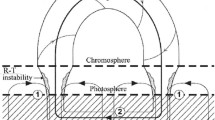Abstract
The magnetic field that fills the corona is rooted in a small fraction of the solar surface. The consequent constriction of the field lines inhibits the conduction of heat down from the corona, thereby strongly affecting the energy balance in the corona and transition region. In this paper, we clarify how the shape of the constriction acts together with the amount of constriction to inhibit the heat flow.
We analyze the heat flow in model tapered flux tubes in which the plasma properties are constant on cross sections, the plasma is static, and the only energy transfer is by thermal conduction. We find:
-
(1)
From the general solution to the model, only two particular solutions are readily applied to the solar atmosphere. One is the steady-state case, appropriate for quiet regions and active regions which are not flaring; the other is the time-dependent case in which no heat enters the hot end, appropriate for conductive cooling of flare loops.
-
(2)
In the steady-state case, the inhibition factor Φ/Φ P (the ratio of the heat flow through a constricted flux tube to the heat flow through the otherwise equivalent unconstricted tube) is simply the ratio of the harmonic mean area of the constricted tube to the area of the unconstricted tube. The inhibition of heat flow thus results from the amount and shape of the constriction.
-
(3)
For any given shape and amount of monotonic tube taper, the inhibition factor in the steady-state case is a good estimate of that in the time-dependent case (within a factor of 2).
-
(4)
The amount of constriction Γ (the ratio of the flux tube's hot end area to its cold end area) limits the range of possible values of the inhibition factor; the value of the inhibition factor within this range is set by the shape of the constriction. For the steady-state case, Γ −1 ≤ Φ/Φ P ≤ 1. Therefore, the shape of the constriction is as important as the amount of constriction in determining the amount of inhibition.
-
(5)
For the linear taper of a cone-shaped tube, the inhibition factor is an especially simple function of the amount of constriction: Φ/Φ P = Γ −1/2. This inhibition-constriction relation for the cone correctly estimates the inhibition to order of magnitude for any tube in which the constriction occurs gradually all along the tube. If the constriction is more concentrated to the hot (cold) end of the tube than in a cone, then the inhibition is greater (less) than in a cone.
-
(6)
Because most flux tubes that pass from the corona down through the transition region should not differ greatly from a cone in shape of constriction, the simple inhibition-constriction relation for the cone should correctly estimate the magnitude of the inhibition in quiet regions, active regions, and flare loops. The only observational input needed for this estimate is the amount of magnetic constriction through the transition region.
Similar content being viewed by others
References
Antiochos, S. K. and Sturrock, P. A.: 1976, Solar Phys. 49, 359.
Athay, R. G.: 1976, The Solar Chromosphere and Corona: Quiet Sun, D. Reidel Publ. Co., Dordrecht, Holland.
Athay, R. G.: 1981, Astrophys. J. 249, 340.
Brown, J. C., Smith, D. F., and Spicer, D. S.: 1981, in S. Jordan (ed.), The Sun as a Star, NASA SP-450, National Aeronautics and Space Administration, Washington, D.C., p. 181.
Gabriel, A. H.: 1976, Phil. Trans. Roy. Soc. London A281, 339.
Kopp, R. A. and Kuperus, M.: 1968, Solar Phys. 4, 212.
Krall, K. R. and Antiochos, S. K.: 1980, Astrophys. J. 242, 374.
Moore, R. L. and Fung, P. C. W.: 1972, Solar Phys. 23, 78.
Moore, R., McKenzie, D. L., Švestka, Z., Widing, K. G., Antiochos, S. K., Dere, K. P., Dodson-Prince, H. W., Hici, E., Krall, K. R., Krieger, A. S., Mason, H. E., Petrasso, R. D., Pneuman, G. W., Silk, J. K., Vorpahl, J. A., and Withbroe, G. L.: 1980, in P. A. Sturrock (ed.), Solar Flares, Colorado Associated University Press, Boulder, Colorado, p. 341.
Nicholas, K. R., Bartoe, J.-D. F., Brueckner, G. E., and Van Hoosier, M. E.: 1979, Astrophys. J. 233, 741.
Orrall, F. Q.: 1981, Solar Active Regions, Colorado Associated Press, Boulder, Colorado.
Rosner, R., Tucker, W. H., and Vaiana, G. S.: 1978, Astrophys. J. 220, 643.
Spitzer, L.: 1962, Physics of Fully Ionized Gases, Wiley Interscience, New York.
Vaiana, G. S. and Rosner, R.: 1978, Ann. Rev. Astron. Astrophys. 16, 393.
Withbroe, G.: 1981, in S. Jordan (ed.), The Sun as a Star, NASA SP-450, National Aeronautics and Space Administration, Washington, D.C., p. 321.
Withbroe, G. L. and Noyes, R. W.: 1977, Ann. Rev. Astron. Astrophys. 15, 363.
Zirker, J. B.: 1977, Coronal Holes and High-Speed Wind Streams, Colorado Associated University Press, Boulder, Colorado.
Author information
Authors and Affiliations
Rights and permissions
About this article
Cite this article
Dowdy, J.F., Moore, R.L. & Wu, S.T. Inhibition of conductive heat flow by magnetic constriction in the corona and transition region: Dependence on the shape of the constriction. Sol Phys 99, 79–99 (1985). https://doi.org/10.1007/BF00157300
Received:
Revised:
Issue Date:
DOI: https://doi.org/10.1007/BF00157300




